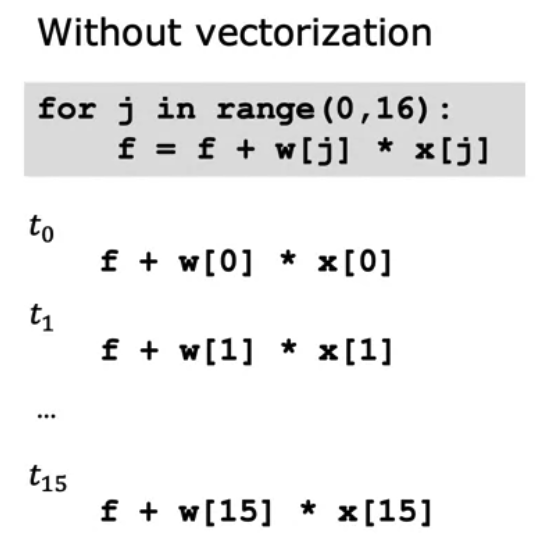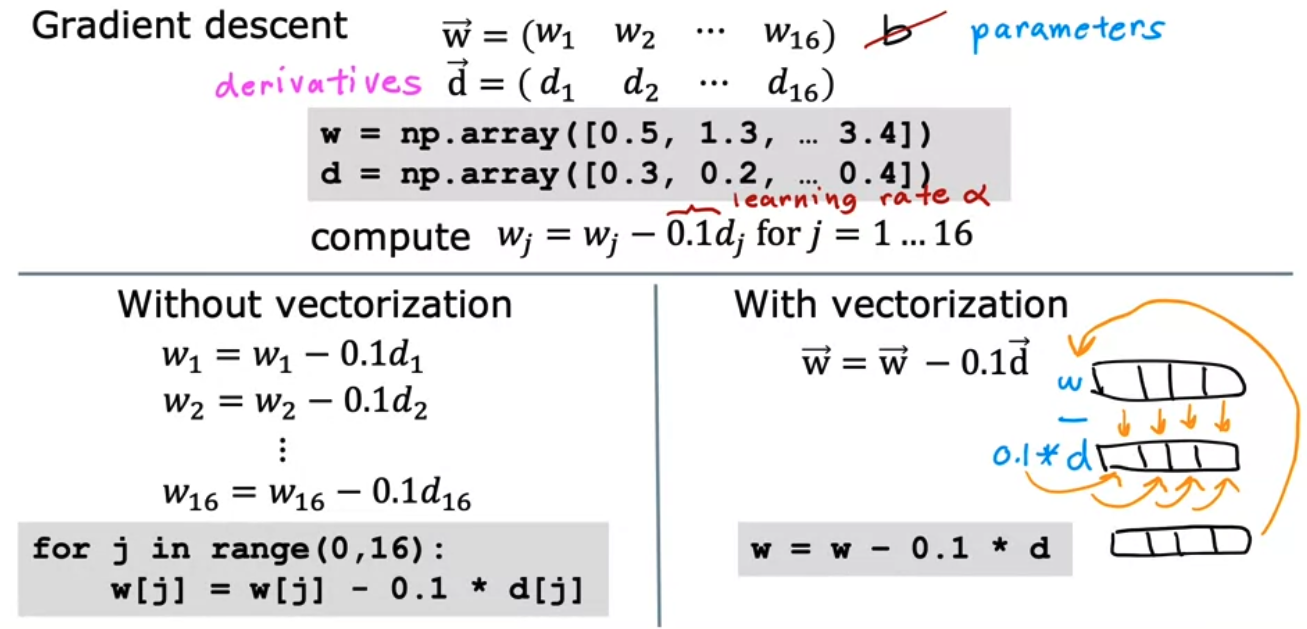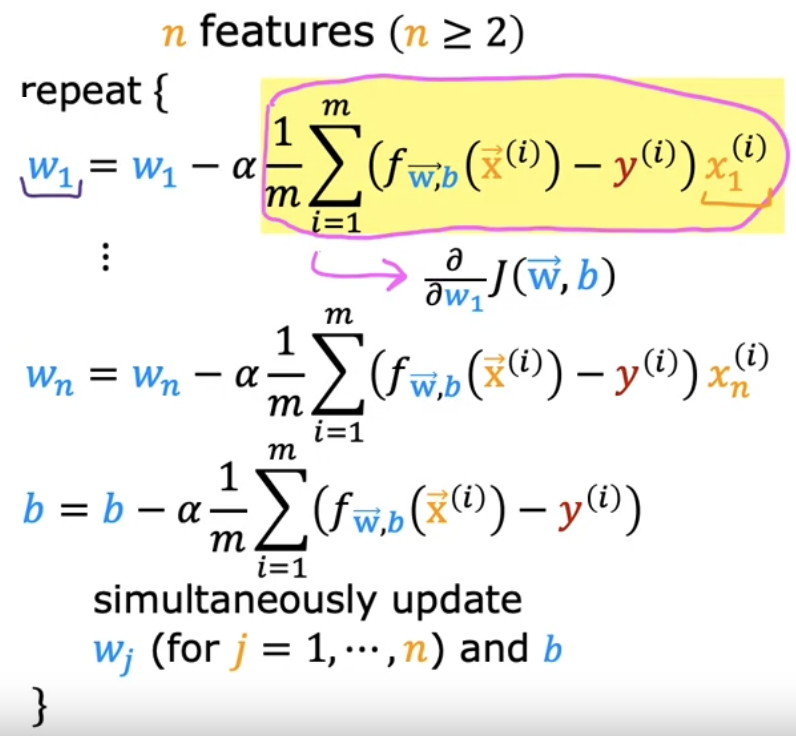Machine Learning - Multiple Linear Regression
Machine Learning - Multiple Linear Regression
해당 포스트는 Andrew Ng 교수님의 Machine Learning Specialization 특화 과정에 대한 정리 내용을 참고하였습니다.
목차
Vectorization
Python Numpy 실습
Gradient Descent With Multiple Variables
Vectorization - 벡터화
- Vectorization 을 사용하여 학습 알고리즘을 구현할 때, 코드를 더 간결하게 작성가능하고 실행 속도도 향상된다. 또한 현대적인 수치선형대수학 라이브러리를 사용 가능하며 GPU 하드웨어를 가속화 하기 위한 코드를 작성하기도 한다.
Parameters and features
- Vectorziation 을 적용하지 않은 방법으로 계산 해보자.
1
2
3
w = np.array([1.0, 2.5, -3.3])
b = 4
x = np.array([10,20,30])
Without Vectorization 1
- 모델의 예측
1
2
3
f = w[0] * x[0] +
w[1] * x[1] +
w[2] * x[2] + b
- 이런 방법은 $n = 100000$ 까지 가면 매우 비효율적임..
Without Vectorization 2
- 따라서 그나마 효율적인 for 문을 돌려보면..
1
2
3
4
f = 0
for j in range(0, n):
f = f + w[j] * x[j]
f = f + b
Vectorization
- Numpy 라이브러리를 사용하여 Vectorization 을 해보면 다음과 같다.
1
f = np.dot(w,x) + b
- np.dot 함수는 컴퓨터의 병렬 하드웨어를 사용할 수 있다. 이는 CPU, GPU 를 사용하더라도 동일하다. 당연하지만 for 루프나 순차적 계산보다 훨씬 효율적임
Vectorization 비교
- 실제로 위의 Without Vectorzation 과 Vectorization 의 코드를 절차적으로 파악하며 비교해보자.
- 직렬적으로 처리
- 병렬적으로 처리
- 벡터화 처리된 코드가 훨씬 빠르고 대규모 데이터 세트에서 알고리즘을 실행하거나 학습시킬 때 효율적이다.
- Gradient Descent 예시
- Vectorization 을 사용하면 선형 회귀를 훨씬 더 효율적으로 구현할 수 있다.
Python Numpy 실습
- Numpy 의 기본 데이터 구조는 동일한 유형 (
dtype)의 요소를 포함하는 인덱싱 가능한 n-dimensional array이다. 여기서 ‘dimension’이라는 용어가 오버로드 되었음을 알 수 있다. 여기서 벡터는 1차원 배열이다. (n,) 을 의미.
Vector Creation
벡터 생성 방법
선형 회귀를 확장하여 여러개의 input feature 를 처리하는 방법을 알아보자. 또한 벡터화 vectorization, 특징 스케일링 feature scaling, 특징 엔지니어링 feature engineering, 다항식 회귀 polynomial regression 등 모델의 훈련과 성능을 개선하기 위한 방법들이 존재한다.
1
2
3
4
# NumPy routines which allocate memory and fill arrays with value
a = np.zeros(4); print(f"np.zeros(4) : a = {a}, a shape = {a.shape}, a data type = {a.dtype}")
a = np.zeros((4,)); print(f"np.zeros(4,) : a = {a}, a shape = {a.shape}, a data type = {a.dtype}")
a = np.random.random_sample(4); print(f"np.random.random_sample(4): a = {a}, a shape = {a.shape}, a data type = {a.dtype}")
1
2
3
np.zeros(4) : a = [0. 0. 0. 0.], a shape = (4,), a data type = float64
np.zeros(4,) : a = [0. 0. 0. 0.], a shape = (4,), a data type = float64
np.random.random_sample(4): a = [0.26311627 0.31122847 0.66214921 0.61216887], a shape = (4,), a data type = float64
1
2
3
# NumPy routines which allocate memory and fill arrays with value but do not accept shape as input argument
a = np.arange(4.); print(f"np.arange(4.): a = {a}, a shape = {a.shape}, a data type = {a.dtype}")
a = np.random.rand(4); print(f"np.random.rand(4): a = {a}, a shape = {a.shape}, a data type = {a.dtype}")
1
2
np.arange(4.): a = [0. 1. 2. 3.], a shape = (4,), a data type = float64
np.random.rand(4): a = [0.09201856 0.10623165 0.29108983 0.30078057], a shape = (4,), a data type = float64
1
2
3
# NumPy routines which allocate memory and fill with user specified values
a = np.array([5,4,3,2]); print(f"np.array([5,4,3,2]): a = {a}, a shape = {a.shape}, a data type = {a.dtype}")
a = np.array([5.,4,3,2]); print(f"np.array([5.,4,3,2]): a = {a}, a shape = {a.shape}, a data type = {a.dtype}")
1
2
np.array([5,4,3,2]): a = [5 4 3 2], a shape = (4,), a data type = int64
np.array([5.,4,3,2]): a = [5. 4. 3. 2.], a shape = (4,), a data type = float64
Operations on Vectors - 벡터 연산
- Indexing
- 배열 내의 위치에 따라 배열의 요소를 참조하는 것을 의미한다.
1
2
3
4
5
6
7
8
9
10
11
12
13
14
15
16
#vector indexing operations on 1-D vectors
a = np.arange(10)
print(a)
#access an element
print(f"a[2].shape: {a[2].shape} a[2] = {a[2]}, Accessing an element returns a scalar")
# access the last element, negative indexes count from the end
print(f"a[-1] = {a[-1]}")
#indexs must be within the range of the vector or they will produce and error
try:
c = a[10]
except Exception as e:
print("The error message you'll see is:")
print(e)
1
2
3
4
5
[0 1 2 3 4 5 6 7 8 9]
a[2].shape: () a[2] = 2, Accessing an element returns a scalar
a[-1] = 9
The error message you'll see is:
index 10 is out of bounds for axis 0 with size 10
- Slicing
- 인덱스를 기반으로 밴열에서 요소의 하위 집합을 얻는 것을 의미한다.
1
2
3
4
5
6
7
8
9
10
11
12
13
14
15
16
17
18
#vector slicing operations
a = np.arange(10)
print(f"a = {a}")
#access 5 consecutive elements (start:stop:step)
c = a[2:7:1]; print("a[2:7:1] = ", c)
# access 3 elements separated by two
c = a[2:7:2]; print("a[2:7:2] = ", c)
# access all elements index 3 and above
c = a[3:]; print("a[3:] = ", c)
# access all elements below index 3
c = a[:3]; print("a[:3] = ", c)
# access all elements
c = a[:]; print("a[:] = ", c)
1
2
3
4
5
6
a = [0 1 2 3 4 5 6 7 8 9]
a[2:7:1] = [2 3 4 5 6]
a[2:7:2] = [2 4 6]
a[3:] = [3 4 5 6 7 8 9]
a[:3] = [0 1 2]
a[:] = [0 1 2 3 4 5 6 7 8 9]
- Vector Operations
1
2
3
4
5
6
7
8
9
10
11
12
13
14
15
16
17
18
19
20
21
22
23
24
25
26
27
28
29
30
31
32
33
34
a = np.array([1,2,3,4])
print(f"a : {a}")
# negate elements of a
b = -a
print(f"b = -a : {b}")
# sum all elements of a, returns a scalar
b = np.sum(a)
print(f"b = np.sum(a) : {b}")
b = np.mean(a)
print(f"b = np.mean(a): {b}")
b = a**2
print(f"b = a**2 : {b}")
a = np.array([ 1, 2, 3, 4])
b = np.array([-1,-2, 3, 4])
print(f"Binary operators work element wise: {a + b}")
#try a mismatched vector operation
c = np.array([1, 2])
try:
d = a + c
except Exception as e:
print("The error message you'll see is:")
print(e)
a = np.array([1, 2, 3, 4])
# multiply a by a scalar
b = 5 * a
print(f"b = 5 * a : {b}")
1
2
3
4
5
6
7
8
9
10
11
12
13
a : [1 2 3 4]
b = -a : [-1 -2 -3 -4]
b = np.sum(a) : 10
b = np.mean(a): 2.5
b = a**2 : [ 1 4 9 16]
Binary operators work element wise: [0 0 6 8]
The error message you'll see is:
operands could not be broadcast together with shapes (4,) (2,)
b = 5 * a : [ 5 10 15 20]
Vector Dot Product - 벡터의 내적
- 내적은 두 벡터의 값을 요소별로 곱한다음 합산하는 과정이다. 두 벡터는 같은 차원이어야함.
1
2
3
4
5
6
7
8
9
10
11
12
13
14
15
16
17
18
19
20
def my_dot(a,b):
"""
Compute the dot product of two vectors
Args:
a (ndarray (n,)): input vector
b (ndarray (n,)): input vector with same dimension as a
Returns:
x (scalar):
"""
x = 0
for i in range(a.shape[0]):
x = x + a[i] * b[i]
return x
# test 1-D
a = np.array([1,2,3,4])
b = np.array([-1,4,3,2])
print(f"my_dot(a, b) = {my_dot(a,b)}")
1
my_dot(a, b) = 24
- Numpy 의 np.dot
1
2
3
4
5
6
7
# test 1-D
a = np.array([1, 2, 3, 4])
b = np.array([-1, 4, 3, 2])
c = np.dot(a, b)
print(f"NumPy 1-D np.dot(a, b) = {c}, np.dot(a, b).shape = {c.shape} ")
c = np.dot(b, a)
print(f"NumPy 1-D np.dot(b, a) = {c}, np.dot(a, b).shape = {c.shape} ")
1
2
NumPy 1-D np.dot(a, b) = 24, np.dot(a, b).shape = ()
NumPy 1-D np.dot(b, a) = 24, np.dot(a, b).shape = ()
- vector vs for loop 속도 비교
1
2
3
4
5
6
7
8
9
10
11
12
13
14
15
16
17
18
19
np.random.seed(1)
a = np.random.rand(10000000) # very large arrays
b = np.random.rand(10000000)
tic = time.time() # capture start time
c = np.dot(a, b)
toc = time.time() # capture end time
print(f"np.dot(a, b) = {c:.4f}")
print(f"Vectorized version duration: {1000*(toc-tic):.4f} ms ")
tic = time.time() # capture start time
c = my_dot(a,b)
toc = time.time() # capture end time
print(f"my_dot(a, b) = {c:.4f}")
print(f"loop version duration: {1000*(toc-tic):.4f} ms ")
del(a);del(b) #remove these big arrays from memory
1
2
3
4
5
# mac m2 pro
np.dot(a, b) = 2501072.5817
Vectorized version duration: 15.5680 ms
my_dot(a, b) = 2501072.5817
loop version duration: 1428.7817 ms
Matrix Creation
1
2
3
4
5
6
7
8
a = np.zeros((1, 5))
print(f"a shape = {a.shape}, a = {a}")
a = np.zeros((2, 2))
print(f"a shape = {a.shape}, a = \n {a}")
a = np.random.random_sample((1, 1))
print(f"a shape = {a.shape}, a = {a}")
1
2
3
4
5
a shape = (1, 5), a = [[0. 0. 0. 0. 0.]]
a shape = (2, 2), a =
[[0. 0.]
[0. 0.]]
a shape = (1, 1), a = [[0.25371341]]
1
2
3
4
5
6
# NumPy routines which allocate memory and fill with user specified values
a = np.array([[5], [4], [3]]); print(f" a shape = {a.shape}, np.array: a = \n {a}")
a = np.array([[5], # One can also
[4], # separate values
[3]]); #into separate rows
print(f" a shape = {a.shape}, np.array: a = \n {a}")
1
2
3
4
5
6
7
8
a shape = (3, 1), np.array: a =
[[5]
[4]
[3]]
a shape = (3, 1), np.array: a =
[[5]
[4]
[3]]
- Indexing
1
2
3
4
5
6
7
8
9
#vector indexing operations on matrices
a = np.arange(6).reshape(-1, 2) #reshape is a convenient way to create matrices
print(f"a.shape: {a.shape}, \na= \n {a}")
#access an element
print(f"\na[2,0].shape: {a[2, 0].shape}, a[2,0] = {a[2, 0]}, type(a[2,0]) = {type(a[2, 0])} Accessing an element returns a scalar\n")
#access a row
print(f"a[2].shape: {a[2].shape}, a[2] = {a[2]}, type(a[2]) = {type(a[2])}")
1
2
3
4
5
6
7
8
9
a.shape: (3, 2),
a=
[[0 1]
[2 3]
[4 5]]
a[2,0].shape: (), a[2,0] = 4, type(a[2,0]) = <class 'numpy.int64'> Accessing an element returns a scalar
a[2].shape: (2,), a[2] = [4 5], type(a[2]) = <class 'numpy.ndarray'>
- Slicing
1
2
3
4
5
6
7
8
9
10
11
12
13
14
15
16
17
18
#vector 2-D slicing operations
a = np.arange(20).reshape(-1, 10)
print(f"a = \n{a}")
#access 5 consecutive elements (start:stop:step)
print("a[0, 2:7:1] = ", a[0, 2:7:1], ", a[0, 2:7:1].shape =", a[0, 2:7:1].shape, "a 1-D array")
#access 5 consecutive elements (start:stop:step) in two rows
print("a[:, 2:7:1] = \n", a[:, 2:7:1], ", a[:, 2:7:1].shape =", a[:, 2:7:1].shape, "a 2-D array")
# access all elements
print("a[:,:] = \n", a[:,:], ", a[:,:].shape =", a[:,:].shape)
# access all elements in one row (very common usage)
print("a[1,:] = ", a[1,:], ", a[1,:].shape =", a[1,:].shape, "a 1-D array")
# same as
print("a[1] = ", a[1], ", a[1].shape =", a[1].shape, "a 1-D array")
1
2
3
4
5
6
7
8
9
10
11
12
a =
[[ 0 1 2 3 4 5 6 7 8 9]
[10 11 12 13 14 15 16 17 18 19]]
a[0, 2:7:1] = [2 3 4 5 6] , a[0, 2:7:1].shape = (5,) a 1-D array
a[:, 2:7:1] =
[[ 2 3 4 5 6]
[12 13 14 15 16]] , a[:, 2:7:1].shape = (2, 5) a 2-D array
a[:,:] =
[[ 0 1 2 3 4 5 6 7 8 9]
[10 11 12 13 14 15 16 17 18 19]] , a[:,:].shape = (2, 10)
a[1,:] = [10 11 12 13 14 15 16 17 18 19] , a[1,:].shape = (10,) a 1-D array
a[1] = [10 11 12 13 14 15 16 17 18 19] , a[1].shape = (10,) a 1-D array
다중 선형 회귀를 위한 경사 하강법
- 기존 단일 변수 선형회귀에서는 단 한개의 feature 가지고 진행했었다.
- 다중 선형 회귀는 집의 크기 뿐만아니라, 방의 수 층수 집의 연차 등을 통해 가격을 예측하는데 더 많은 정보를 얻을 수 있다.
- feature 가 2개 이상인 경우
- $w_1, \dots , w_n, b$ 까지 업데이트를 진행한다.
Normal equation - 정규 방정식
- $w, b$ 를 찾기 위한 또 다른 방법으로는 정규 방정식이 존재한다.
- 경사 하강법은 비용함수 $J$ 를 최소화하여 $w, b$ 를 찾는 매우 훌룡한 방법이지만, $w, b$ 를 찾는 또 다른 알고리즘이 존재하는데 이를 정규 방정식이라고 한다.
- 정규 방정식은 오로지 선형 회귀에만 적용된다. 로지스틱 회귀 같은 곳에서는 적용할 수 없음.
- 장점
- 반복없이 한 번에 $w, b$ 를 해결할 수 있다.
- 단점
- 다른 학습 알고리즘 (로지스틱 회귀, 신경망 등) 에서 일반화되지 않는다.
- feature 의 수가 많으면 정규 방정식은 매우 느리다.
- 주로 어디서 사용하느냐?
- 일부 머신러닝 라이브러리에서는 백엔드 단에서 정규 방정식을 활용하여 $w, b$ 를 구하기도 한다. 경사하강법이 훨씬 낫다.
This post is licensed under CC BY 4.0 by the author.






